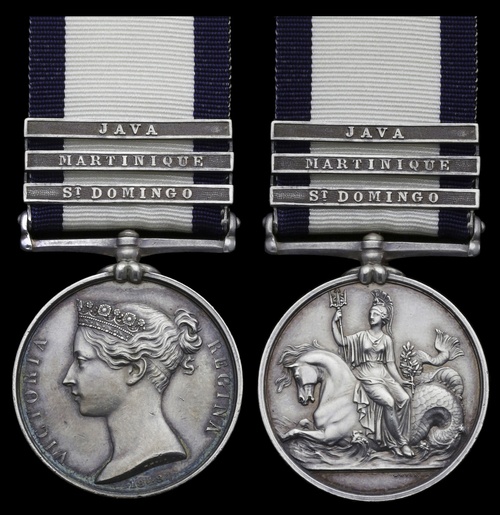
Auction: 20002 - Orders, Decorations, Medals & Space Exploration
Lot: 6
The 3-clasp Naval General Service Medal awarded to Yeoman of the Sheets S. Jeffery, Royal NavyNaval General Service 1793-1840, 3 clasps St Domingo, Martinique, Java (Samuel Jeffery.), good very fine
Provenance:
McKenzie Collection, 1873.
Eaton Collection, 1880.
Chelseymore Collection, 1930.
Spink, 1990.
A unique name upon the rolls, one of three Medals with this combination of clasps.
Samuel Jeffery - whose name was also spelt Jeffery and Jeffries during his career - entered the Royal Navy aboard Niobe on 24 September 1803. A little over two months of having been on board, Jeffery would have been present when Sir George Rumbold was returned to England. Rumbold had been taken prisoner by the French, who effectively invaded Hanover to abduct him. Taken to confinement in Paris, he was finally released and transferred back to Blighty on the personal orders of Napoleon, via a French cutter under the flag of truce that delivered him to the Niobe and onto Portsmouth.
Joining Acasta in 17 November, he was in the rate of Able Seaman for the Battle of St Domingo on 6 February 1806. With Acasta on the windward of the line-of-battle ships, she was responsible for taking possession of Brave, which had struck her colours after being mauled by Donegal. This swift move allowed Donegal to pour fire into Jupiter and keep the momentum for a resounding victory. Acasta also came to the help of the sinking Imperial and Diomede two days later, saving her crews and taking some 156 prisoner. The battle cost the British 74 killed and 264 wounded, whilst the French lost 1,510.
Acasta was serving in the Channel in 1807 when Captain Richard Dunn came to take the command, taking her on two convoy escorts to the British Leeward Islands. Returned to the Leewards, she captured the French brigatine, Le Serpent, on 17 July 1808. Captain Beaver was responsible for the landing of troops on Martinique from Acasta. The landing was a success and Jeffery would add a second clasp to his Medal for his part. His final action in that period would be during the capture of the Iles de Saintes, a result of Admiral Cochrane blockading the French ships that had taken shelter there. Sailing from Martinique on 12 Apil with several thousand troops and Captain Beaver as Commodore of the Division aboard Acasta, leading to a landing on 14 April and three days of fighting. The vessels had slipped away but the British reduced the French forts and captured the troops. Acasta returned to England.
Discharged on 5 October 1809, Jeffery was immediately raised to Yeoman of the Sheets and transferred for service, together with 25 men to the Scipion. That vessel had itself started its life in the French Navy and had been captured at the Battle of Trafalgar and was commissioned into service in July 1809 in the Channel Squadron. By October 1810 she became Flagship of Admiral Sir Robert Stopford and set for the Cape of Good Hope and onto the East Indies, making for Australia and Batavia. Preparing for the invasion of Java in July 1811, she stopped at the island of Rispondi in dire need of water and supplies. Moving ashore under a flag of truce, the natives and their Rajah welcomed the party, under Master Sisk who had promised to pay handsomly for assistance. Led into the forest, the party were quickly set upon and tied up, before being taken to a Dutch fort on the island. Captain Bunce took a party of the 14th Foot and some Bluejackets ashore the next morning to try and locate their comrades. Firing a broadside into the jungle as they approached, the party burned a large village and the Palace of a Rajah. The tide had gone out and having decided it was time to depart, the party were force to swim a mile out to their ship. A number of similar raids took place on the following days and it seems Master Fisk and his original party had been removed from the island. They called it a day and left to rejoin the preparations for the invasion of Java. After the original landing on 8 August, a number of subsequent actions took place in order to secure the island in which the crew of Scipion shared. They had counted 1 killed, with a further 3 Officers (Stopford lost and arm to a cannon-ball), 12 Seamen and Marines wounded.
Jeffery would also play his part during the action off Toulon on 5 November 1813, when Scipion opened fire from her larboard guns at 12.34pm, followed by Mulgrave, Pembroke, Armada and Pompee. Six minutes later she wore in order to fire a starboard broadside. Returned to Deal on 22 September 1814, she was paid off at Portsmouth on 27 October and Jeffery returned to his wife; sold together with a detailed file of copied research.
Subject to 20% VAT on Buyer’s Premium. For more information please view Terms and Conditions for Buyers.
Sold for
£4,000
Starting price
£2800




